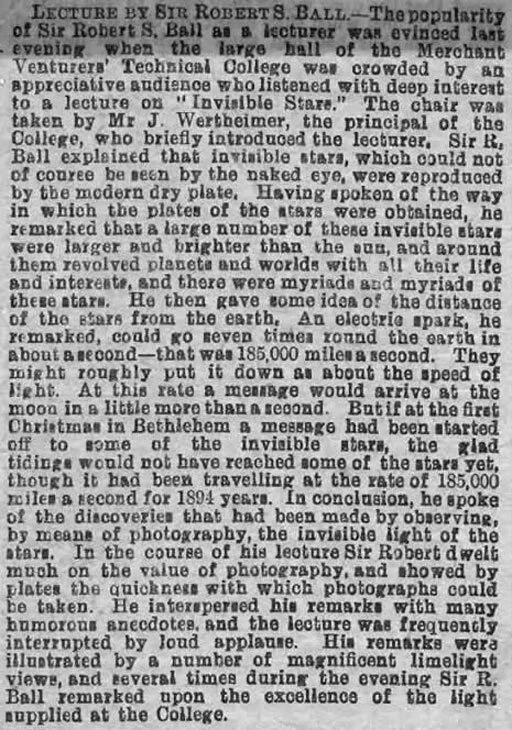Lecture in 1894 About Invisible Stars by Sir Robert S. Ball
[Reference to a Lecture by Sir Robert Stawell Ball (1840-1913), Irish astronomer]
LECTURE BY SIR ROBERT S. BALL. – The popularity of Sir Robert S. Ball as a lecturer was evinced last evening when the large hall of the Merchant Venturers’ Technical College was crowded by an appreciative audience who listened with deep interest to a lecture on “Invisible Stars.” The chair was taken by Mr J. Wertheimer, the principal of the College, who briefly introduced the lecturer. Sir R. Ball explained that invisible stars, which could not of course be seen by the naked eye, were reproduced by the modern dry plate. Having spoken of the way in which the plates of the stars were obtained, he remarked that a large number of these invisible stars were larger and brighter than the sun, and around them revolved planets and worlds with all their life and interests, and there were myriads and myriads of these stars. He then gave some idea of the distance of the stars from the earth. An electric spark, he remarked, could go even times round the earth in about a second – that was 185,000 miles a second. They might roughly put it down as about the speed of light. At this rate a message would arrive at the moon in a little more than a second. But if at the first Christmas in Bethlehem a message had been started off to some of the invisible stars, the glad tidings would not have reached some of the stars yet, though it had been traveling at the rate of 185,000 miles a second for 1894 years. In conclusion, he spoke of the discoveries that had been made by observing, by means of photography, the invisible light of the stars. In the course of his lecture Sir Robert dwelt much on the value of photography, and showed by plates the quickness with which photographs could be taken. He interspersed his remarks with many humorous anecdotes, and the lecture was frequently interrupted by the loud applause. His remarks were illustrated by a number of magnificent limelight views, and several times during the evening Sir R. Ball remarked upon the excellence of the light supplied at the College.
